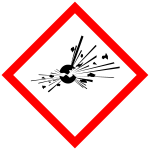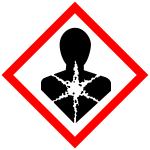Notified classification and labelling according to CLP criteria
General Section
EC / List no.

|
Name |
CAS Number

|
Additional Notified Information

|
|---|---|---|---|
| 200-838-9 | dichloromethane; methylene chloride | 75-09-2 |
State/Form
|
| Classification | Labelling | Specific Concentration limits, M-Factors | Notes |
Classification affected by Impurities / Additives

|
||
|---|---|---|---|---|---|---|
| Hazard Class and Category Code(s) | Hazard Statement Code(s) | Hazard Statement Code(s) | Supplementary Hazard Statement Code(s) | |||
| Ozone 1 | EUH059 | EUH001 EUH018 |
Skin Corr. 1B; : 50 % < C < 1 % Press. Gas (Ref. Liq.); : 50 % < C < 1 % Ox. Liq. 2; : 50 % < C < 1 % Self-react. A; : C < 1 % Press. Gas (Liq.); : C < 1 % Muta. 1B; : 50 % < C < 1 % Press. Gas (Ref. Liq.); : C < 1 % Press. Gas (Diss.); : C < 1 % M=100 |
Note B
Note H Note G Note F Note E Note K Note A Note C Note D Note J |
||
| Expl. 1.1 | H200 | |||||
| H202 | ||||||
| Flam. Gas 1 | H220 | |||||
| Aerosol 1 | H222,H229 | |||||
| Flam. Liq. 1 | H224 | |||||
| Flam. Sol. 1 | H228 | |||||
| Org. Perox. A | H240 | |||||
| Self-react. A | H241 | |||||
| Pyr. Liq. 1 | H250 | |||||
| Pyr. Sol. 1 | H250 | |||||
| Self-heat. 1 | H251 | |||||
| Water-react. 1 | H260 | |||||
| Ox. Gas 1 | H270 | |||||
| Ox. Sol. 1 | H271 | |||||
| Ox. Liq. 1 | H271 | |||||
| Press. Gas (Comp.) | H280 | |||||
| Met. Corr. 1 | H290 | |||||
| Acute Tox. 1 | H300 | |||||
| Asp. Tox. 1 | H304 | |||||
| Acute Tox. 1 | H310 | |||||
| Skin Corr. 1A | H314 | |||||
| Skin Sens. 1 | H317 | |||||
| Eye Dam. 1 | H318 | |||||
| Acute Tox. 1 | H330 | |||||
| Resp. Sens. 1 | H334 | |||||
| Muta. 1A | H340 (oral) | |||||
| Carc. 2 | H351 (oral) | H351 (more) | ||||
| Repr. 1A | H360 (oral) (test) | |||||
| Repr. 1A | H360 (test) | |||||
| Lact. | H362 | |||||
| STOT SE 1 | H370 (other:test) (oral) | |||||
| STOT RE 1 | H372 (other:test) (oral) | |||||
| H400 | ||||||
| Aquatic Chronic 1 | ||||||
| Signal Words | Pictograms | ||||||
|---|---|---|---|---|---|---|---|
| Warning |
|
Detailed Information on classification and labelling
Classification
| Physical and Chemical hazards | |||
|---|---|---|---|
| Hazard Category | Hazard Statement |
Reason for no Classification

|
|
| Explosives | Expl. 1.1 | H200 | |
| Flammable Gases and Chemically Unstable Gases | Flam. Gas 1 | H220 | |
| Flammable Aerosols | Aerosol 1 | H222,H229 | |
| Oxidising Gases | Ox. Gas 1 | H270 | |
| Gases Under Pressure | Press. Gas (Comp.) | H280 | |
| Flammable Liquids | Flam. Liq. 1 | H224 | |
| Flammable Solids | Flam. Sol. 1 | H228 | |
| Self-reactive Substances and Mixtures | Self-react. A | H241 | |
| Pyrophoric Liquids | Pyr. Liq. 1 | H250 | |
| Pyrophoric Solids | Pyr. Sol. 1 | H250 | |
| Self-heating Substances and Mixtures | Self-heat. 1 | H251 | |
| Substances and Mixtures which in contact with water emit flammable gases | Water-react. 1 | H260 | |
| Oxidising Liquids | Ox. Liq. 1 | H271 | |
| Oxidising Solids | Ox. Sol. 1 | H271 | |
| Organic Peroxides | Org. Perox. A | H240 | |
| Substances and Mixtures corrosive to Metals | Met. Corr. 1 | H290 | |
| Desensitized Explosives | Data lacking | ||
| Human Health hazards | |||
| Hazard Category | Hazard Statement |
Reason for no Classification

|
|
| Acute Toxicity - Oral | Acute Tox. 1 | H300 | |
| Acute Toxicity - Dermal | Acute Tox. 1 | H310 | |
| Acute Toxicity - Inhalation | Acute Tox. 1 | H330 | |
| Skin Corrosion / Irritation | Skin Corr. 1A | H314 | |
| Serious Eye Damage / Eye Irritation | Eye Dam. 1 | H318 | |
| Respiratory Sensitisation | Resp. Sens. 1 | H334 | |
| Skin Sensitisation | Skin Sens. 1 | H317 | |
| Aspiration Hazard | Asp. Tox. 1 | H304 | |
| Germ Cell Mutagenicity | Hazard Category | Hazard Statement |
Reason for no Classification

|
| Germ Cell Mutagenicity | Muta. 1A | H340 | |
| Route of exposure | oral | ||
| Carcinogenicity | Hazard Category | Hazard Statement |
Reason for no Classification

|
| Carcinogenicity | Carc. 2 | H351 | |
| Route of exposure | oral | ||
| Reproductive Toxicity | Hazard Category | Hazard Statement |
Reason for no Classification

|
| Reproductive Toxicity | Repr. 1A | H360 | |
| Specific Effect | test | ||
| Reproductive Toxicity | Repr. 1A | H360 | |
| Specific Effect | test | ||
| Route of exposure | oral | ||
| Effects on or via Lactation | Lact. | H362 | |
| Specific target organ toxicity - Single | Hazard Category | Hazard Statement |
Reason for no Classification

|
| Specific target organ toxicity - Single | STOT SE 1 | H370 | |
| Affected Organs | other:test | ||
| Route of exposure | oral | ||
| Specific target organ toxicity - Repeated | Hazard Category | Hazard Statement |
Reason for no Classification

|
| Specific target organ toxicity - Repeated | STOT RE 1 | H372 | |
| Affected Organs | other:test | ||
| Route of exposure | oral | ||
| Environmental Hazards | |||
| Hazardous to the aquatic environment | Hazard Category | Hazard Statement |
Reason for no Classification

|
| Hazardous to the aquatic environment - acute | H400 | ||
| Hazardous to the aquatic environment - chronic | Aquatic Chronic 1 | ||
| Hazardous to the atmospheric environment | Hazard Category | Hazard Statement |
Reason for no Classification

|
| Hazardous to the ozone layer | Ozone 1 | EUH059 | |
| Additional Hazard Classes | Additional Hazard Statements |
|---|---|
| Aquatic Chronic 1 | H400: Very toxic to aquatic life. |
Labelling
| Hazard Statement Code(s) | Phrase | Additional Text |
|---|---|---|
| H202 | Explosive; severe projection hazard. | |
| H351 | Suspected of causing cancer |
more |
| Note Title | Note Text |
|---|---|
| Note B | Some substances (acids, bases, etc.) are placed on the market in aqueous solutions at various concentrations and, therefore, these solutions require different classification and labelling since the hazards vary at different concentrations. , In Part 3 entries with Note B have a general designation of the following type: "nitric acid … %". , In this case the supplier must state the percentage concentration of the solution on the label. Unless otherwise stated, it is assumed that the percentage concentration is calculated on a weight/weight basis. |
| Note H | The classification and labelling shown for this substance applies to the hazardous property(ies) indicated by the hazard statement(s) in combination with the hazard class(es) and category(ies) shown. The requirements of Article 4 for manufacturers, importers or downstream users of this substance apply to all other hazard classes and categories. For hazard classes where the route of exposure or the nature of the effects leads to a differentiation of the classification of the hazard class, the manufacturer, importer or downstream user is required to consider the routes of exposure or the nature of the effects not already considered. , The final label shall follow the requirements of Article 17 and of section 1.2 of Annex I. , The classification and label shown for this substance applies to the dangerous property(ies) indicated by the risk phrase(s) in combination with the category(ies) of danger shown. Manufacturers, importers and downstream users of this substance shall be obliged to carry out an investigation to make themselves aware of the relevant and accessible data which exists for all other properties to classify and label the substance. The final label shall follow the requirements of section 7 of Annex VI to Directive 67/548/EEC. |
| Note G | This substance may be marketed in an explosive form in which case it must be evaluated using the appropriate test methods. The classification and labelling provided shall reflect the explosive properties. |
| Note F | This substance may contain a stabiliser. If the stabiliser changes the hazardous properties of the substance, as indicated by the classification in Part 3, classification and labelling should be provided in accordance with the rules for classification and labelling of hazardous mixtures. |
| Note E | Substances with specific effects on human health (see Chapter 4 of Annex VI to Directive 67/548/EEC) that are classified as carcinogenic, mutagenic and/or toxic for reproduction in categories 1 or 2 are ascribed Note E if they are also classified as very toxic (T+), toxic (T) or harmful (Xn). For these substances, the risk phrases R20, R21, R22, R23, R24, R25, R26, R27, R28, R39, R68 (harmful), R48 and R65 and all combinations of these risk phrases shall be preceded by the word "Also". |
| Note K | The classification as a carcinogen or mutagen need not apply if it can be shown that the substance contains less than 0,1 % w/w 1,3- butadiene (EINECS No 203-450-8). If the substance is not classified as a carcinogen or mutagen, at least the precautionary statements (P102-)P210-P403 should apply. This note applies only to certain complex oil-derived substances in Part 3. |
| Note A | Without prejudice to Article 17(2), the name of the substance must appear on the label in the form of one of the designations given in Part 3. , In Part 3, use is sometimes made of a general description such as "... compounds" or "... salts". In this case, the supplier is required to state on the label the correct name, due account being taken of section 1.1.1.4. |
| Note C | Some organic substances may be marketed either in a specific isomeric form or as a mixture of several isomers. , In this case the supplier must state on the label whether the substance is a specific isomer or a mixture of isomers. |
| Note D | Certain substances which are susceptible to spontaneous polymerisation or decomposition are generally placed on the market in a stabilised form. It is in this form that they are listed in Part 3. , However, such substances are sometimes placed on the market in a non-stabilised form. In this case, the supplier must state on the label the name of the substance followed by the words "non-stabilised". |
| Note J | The classification as a carcinogen or mutagen need not apply if it can be shown that the substance contains less than 0,1 % w/w benzene (EINECS No 200-753-7). This note applies only to certain complex coal- and oil-derived substances in Part 3. |

